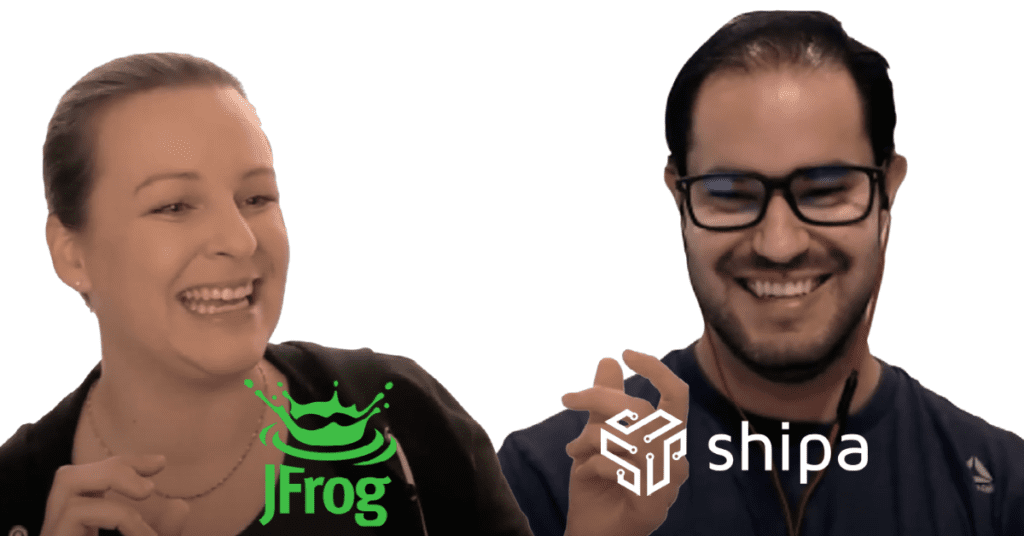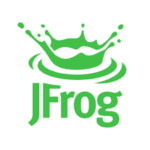Fearless Delivery with an End-to-End DevOps Platform
“Leap-Frog Over your Kubernetes Obstacles”
In this episode of Coffee & Containers, Bruno Andrade, Founder/CEO @ Shipa, and Melissa McKay, Developer Advocate @ JFrog, discuss some specific Kubernetes related obstacles:
- Artifact Repositories in CloudNative
- Liquid Software
- Post-deployment application management

Excerpts from the discussion:
Managing repos in
MELISSA: I think the best thing I can point out there is just, there are so many more binaries, libraries’ dependencies every day than ever before. So it’s, it’s becoming a thing, it’s becoming more difficult to manage. It’s like buying a new pair of shoes every day, and you got to stuff them all in the same closet, you know? And then you got to find the pair you wanted to wear that day.
BRUNO: I like to use the pizza analogy. A lot of people really get stuck on trying to put together all of the ingredients, right? Then, the pepperoni, making the dough, et. In terms of development, those are the objects, right? So you have to put in your image, then your rules, your deployment says they’re clustered, then you add a security scan, and you’re trying to tie all of this together. If you’re doing this for a small service or a small number of services, or a small team, you may get away with it. But as you scale, and we work with companies that are deploying a hundred, 200, or 500 services across thousands of developers, this is just a nightmare. So if you can have an integrated process that basically brings your ingredients together for you automatically and allows you to focus on eating the pizza, which is the part I like, that’s just a win-win situation, right?
Liquid Software
MELISSA: We often see continuous delivery pipelines. That means everything is automated, but there is that one extra step that somebody has to push that button to actually deploy to an environment. We get stuck at continuous integration where we have that setup, we’ve got our builds automated, our unit testing automated, but then what do we do? I see some pretty strong use case scenarios here, especially for staging environments and testing environments, on top of your production environment to make this a little bit easier for different teams to get their software through these quality gates and out the door faster.
BRUNO: I’m basically storing that image into Artifactory. And as soon as it is done, I’m applying to Shipa. So as a developer, I don’t have to learn what Kubernetes is. I don’t have to see anything, GKE. I don’t need to know what the deployment versions and API versions are. I don’t have to learn or interface with any of that. I get my application, and I deploy my application pointing to the pool that my DevOps person gave to me. And that’s it, I’m just applying my image, or I’m deploying my application through the CI pipeline. I can do that directly from Git, and I can see the logs. The steps and the status of each.


Post-Deployment
MELISSA: My first experiences on a DevOps team were pretty eye-opening. I had no idea the acrobats that operations was taking to deploy some of the apps that we had. This is when I first started getting interested in containers. I know that that’s another thing that can be obstructed away from developers, but that was something that I was really curious about and got into. So I learned how to build containers efficiently so that they can be deployed more efficiently. But some of the things that happened in my experience was, months after an app was deployed, all of a sudden somebody sends an email, “Hey, these containers are restarting all the time.” Some of our tools that we use to keep our apps up and running are causing the problem.
BRUNO: We have integrations into different incident management tools, such as Slack, where if the application is getting restarted, or if a deployment fails or succeeds, you can set up alerts on Slack, PagerDuty, and all of your other incident management tools where you can alert the developer and so on. The better you can implement the controls and guard-rails and just leverage the infrastructure, the more you can focus on the app and the controls around it and not be bogged down by the infrastructure.
Watch the full webcast here:
Leap-frog over your kubernetes obstacles with JFrog and Shipa
Resources:
A Vision of Liquid Software Whitepaper: https://jfrog.com/whitepaper/a-vision-of-liquid-software/
JFrog Artifactory – Start for Free: https://jfrog.com/artifactory/start-free/
PodInfo application – https://github.com/brunoa19/podinfo
Melissa McKay is a long time developer turned international speaker and is currently a Developer Advocate for JFrog, Inc., with a mission to improve the developer experience of DevOps methodologies. Her background and experience as a software engineer spans a slew of languages, technologies, and tools used in the development and operation of enterprise products and services. She is a mom, software engineer, Java geek, huge fan of UNconferences, and is always on the lookout for ways to grow and learn. She has a passion for teaching, sharing, and inspiring fellow practitioners and you are more than likely to run into her in the conference circuit.
Bruno Andrade is CEO and Founder of Shipa. He has led distributed systems design and implementation at enterprises across different industries, defining methodologies, concepts and architecture and has dedicated the last few years to working on the Cloud Native space helping companies through a successful journey.
Try Shipa Today!
Full lifecycle application-centric framework for Kubernetes so everyone can focus on applications, and not Kubernetes obstacles
Get Started
Share on email
Email
Share on twitter
Twitter
Share on linkedin
LinkedIn


